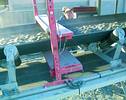

A new range of metal detection equipment on the South African market promises to assist local mining companies in eliminating the damage caused to machinery by tramp metal.
Tramp metal - pieces of unwanted metal that end up in expensive processing equipment such as crushers and mills - results in costly repairs and downtime. These pieces of metal usually originate from broken equipment, such as jaw-crusher teeth, screens or shoots; or from tools, such as wrenches and spanners - which accidentally land up in processing circuits where they cause damage.
Local engineering company, PJ Tech, of Phalaborwa, in Limpopo province, believes that it has the solution to most of the challenges faced by mining companies in detecting tramp metal. At the beginning of the year the firm was appointed as the exclusive southern African distributor of Tectron conveyor mounted metal-detection equipment, which is based in the US. It has since supplied two of these detectors to the Tati nickel-mine in Botswana, and is currently negotiating the sale of machines to a South African copper-mine, as well as platinum-mining companies.
PJ Tech MD, Peter Nowakowski, says that the technology employed in the Tectron range allows the equipment to accurately distinguish between ores with a high mineral content, which are highly conductive, and pieces of tramp metal on conveyor belts. According to Nowakowski, there are several ranges of other metal-detection equipment available locally. However, he maintains that the high mineral content of some of the ores mined locally makes it difficult for the equipment to differentiate between tramp metal and ore.
Nowakowski says that the Tectron range, on the other hand, overcomes this seemingly impossible challenge and can be programmed to ignore highly-conductive ores and steel cord belts while detecting magnetic, nonmagnetic, ferrous, and nonferrous tramp metal.
Operation
The equipment, which incorporates a pulsed eddy current design, generates a pulsed inductive field in a transmitter coil. A receiver coil, which is only active when the transmitter is inactive, monitors the field. An electric pulse energises the transmitter at regularly spaced intervals. As the transmitter coil's energy field collapses, it momentarily creates a strong electromagnetic field, which induces energy into any metal particle passing through the detector. When the energised particle discharges the energy, the receiver coil picks up the currents within the metal. The receiver electronics are set up to discriminate between the return signals. When tramp metal is detected, the conveyor belt stops and the alarm is activated.
Nowakowski says that besides its ability to operate in difficult product applications, another benefit of the system is the ease at which it can be installed. The transmitter and receiver antennas can be installed without cutting the belt or dismantling the conveyor. Similarly, the replacement of components does not require cutting or dismantling of the conveyor belt.
About Tectron
Founded in 1967, Tectron is located in Laguna Hills, in California, where it occupies an 11 000 m2 manufacturing facility. The company has more than 4000 metal detectors in service in the aggregate, mining, paper and pulp, wood products and recycling industries.
For more information contact PJ Tech, 082 377 9405, [email protected], www.pjtech.co.za
| Tel: | +27 11 704 7088 |
| Email: | [email protected] |
| www: | www.pjtech.co.za |
| Articles: | More information and articles about PJ Tech |

© Technews Publishing (Pty) Ltd | All Rights Reserved